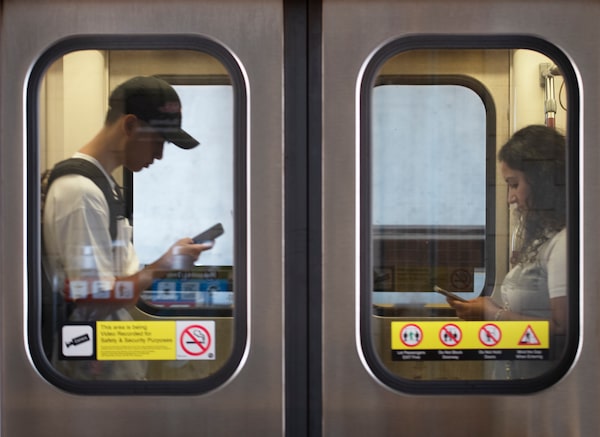
TTC passengers use their mobile phones while heading south on the Yonge subway line in Toronto, on Aug 21.Fred Lum/The Globe and Mail
Rogers Communications Inc. RCI-B-T has launched 5G service on the “busiest sections” of Toronto’s subway system, the company announced Wednesday amid a dispute with rival telecoms that have been seeking access to the Rogers-owned network.
The Toronto-based telecom made the decision to launch the service during consultations by federal Industry Minister François-Philippe Champagne, whose department had proposed a condition that would prohibit Rogers from going ahead before coming to terms with BCE Inc. BCE-T and Telus Corp. T-T.
Mr. Champagne on Wednesday vowed to take “decisive action” to ensure that all carriers are able to offer service inside Toronto Transit Commission subway tunnels.
“If you’re a Canadian, regardless if you have Rogers, Bell or Telus on your phone, you should have coverage in the subway system,” Mr. Champagne told reporters during a news conference in Charlottetown.
“My mission is to make sure that people have coverage regardless of the network they choose,” he added.
The dispute between Rogers and its two main competitors began months ago, after Rogers announced it was acquiring BAI Canada Inc., the Canadian branch of an Australian telecommunications infrastructure company with the sole right to develop wireless infrastructure inside the subway system.
BCE had asked Canada’s telecom regulator for an order prohibiting Rogers from onboarding its own customers onto the network until it is able to provide access to all wireless carriers. The company, along with Telus, had also asked Mr. Champagne to intervene in the spat.
Mr. Champagne, whose department issues licences for spectrum – the airwaves used to transmit wireless services – launched a consultation in July with a view to potentially imposing additional conditions on those licences.
Rogers, Bell and Telus all made submissions to Innovation, Science and Economic Development (ISED) as part of that consultation process.
Rogers said in its filing that it “strongly objects” to a federal government proposal that would prohibit it from launching services in the subway system for its own customers before coming to terms with the other carriers.
Rogers said in a press release on Wednesday that its customers now have fifth-generation wireless service – allowing them to talk, text and stream – on all stations and tunnels in the “Downtown U” portion of the subway, as well as Spadina and Dupont stations.
Service is also available on 13 stations from Keele to Castle Frank, as well as the tunnels between St. George and Yonge stations. The company said it has also made 911 service “more reliable” in these areas by deploying additional spectrum.
All carriers have an Aug. 28 deadline to submit their replies to ISED.
“TTC and Rogers staff worked hard to make this happen quickly and I look forward to the full build out being completed with all wireless carriers signing on to the network,” Rick Leary, CEO of the Toronto Transit Commission, said in a statement.
Rogers CEO Tony Staffieri called it an “important milestone.”
“We’re working hard to modernize and expand the network so all riders can reliably access 911 and connect to 5G everywhere across the subway system, including underground,” he said in a statement.
BCE, meanwhile, accused Rogers of attempting to “advantage itself at the expense of Toronto residents” and “showing brazen disregard for the ongoing consultation.”
“That consultation proposes conditions of license that would compel Rogers to provide access to all wireless carriers so that all TTC riders can have reliable connectivity on the subway,” BCE spokesperson Ellen Murphy said in a statement.
“Rogers’s decision also goes against the recommendation of many community groups like the Women Abuse Council of Toronto, CodeRed TO, Toronto YWCA and Toronto Police Service, all of whom advocate that wireless connectivity on the TTC is a public safety issue, and needs to be available to everyone as soon as possible regardless of carrier,” she added.
Richard Gilhooley, a spokesperson for Telus, said the company is “outraged that Rogers has restricted access to internet connectivity on the TTC.”
“The TTC is a public service paid for by the people of Toronto, and everyone should have equal access to connectivity and the added safety it provides. Rogers has demonstrated a complete lack of co-operation on access for all riders, refusing to meet with other carriers or grant roaming access,” Mr. Gilhooley said in a statement.
Rogers, meanwhile, accused Bell and Telus of “playing games” instead of negotiating on behalf of their customers.
“We continue to respectfully participate in the federal government’s consultation process,” Rogers spokesperson Cam Gordon said in a statement.
The company said that turning off the 5G network would also turn off the enhancements it has made to 911 service. In its submission to the federal government, Rogers said it is “not currently technically feasible for Rogers to provide wholesale roaming services to Bell or Telus in the TTC.”
With a report from Marieke Walsh